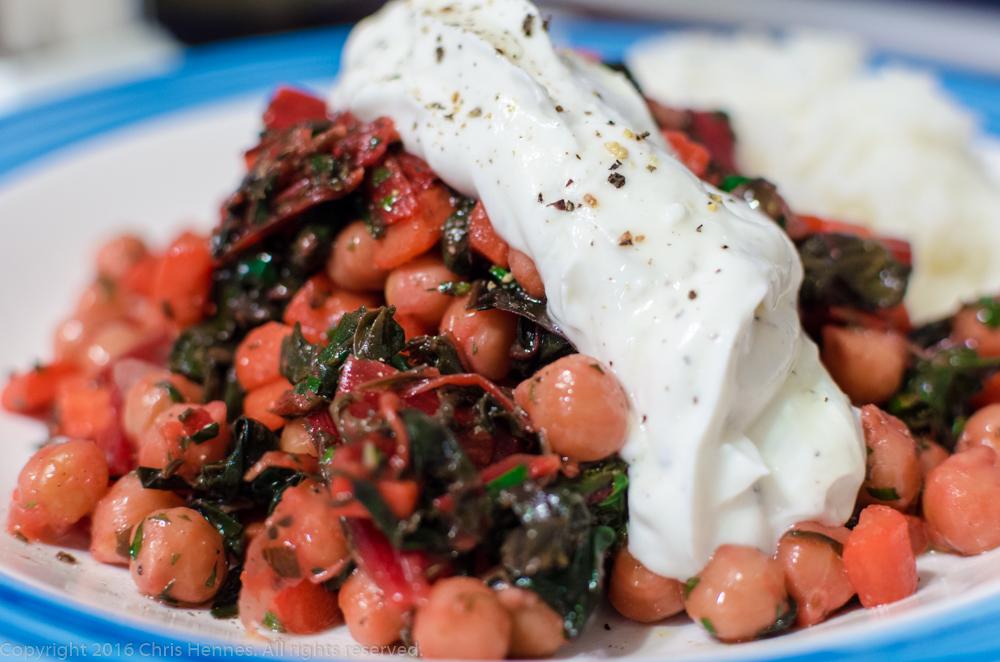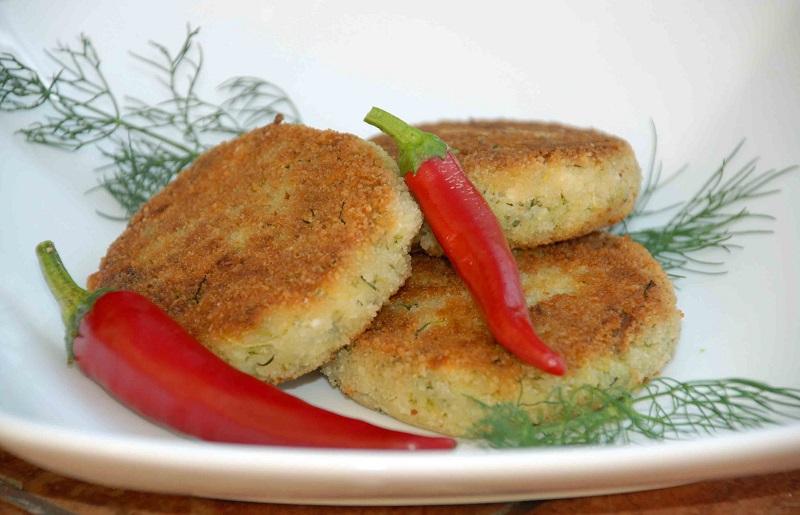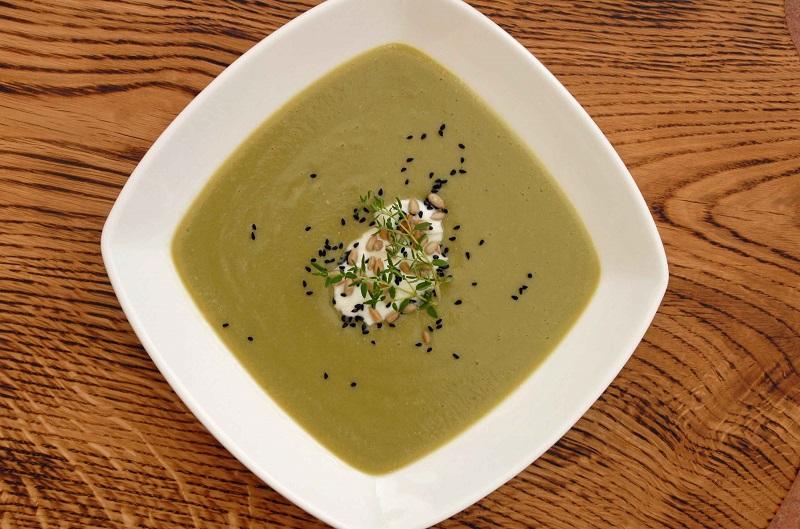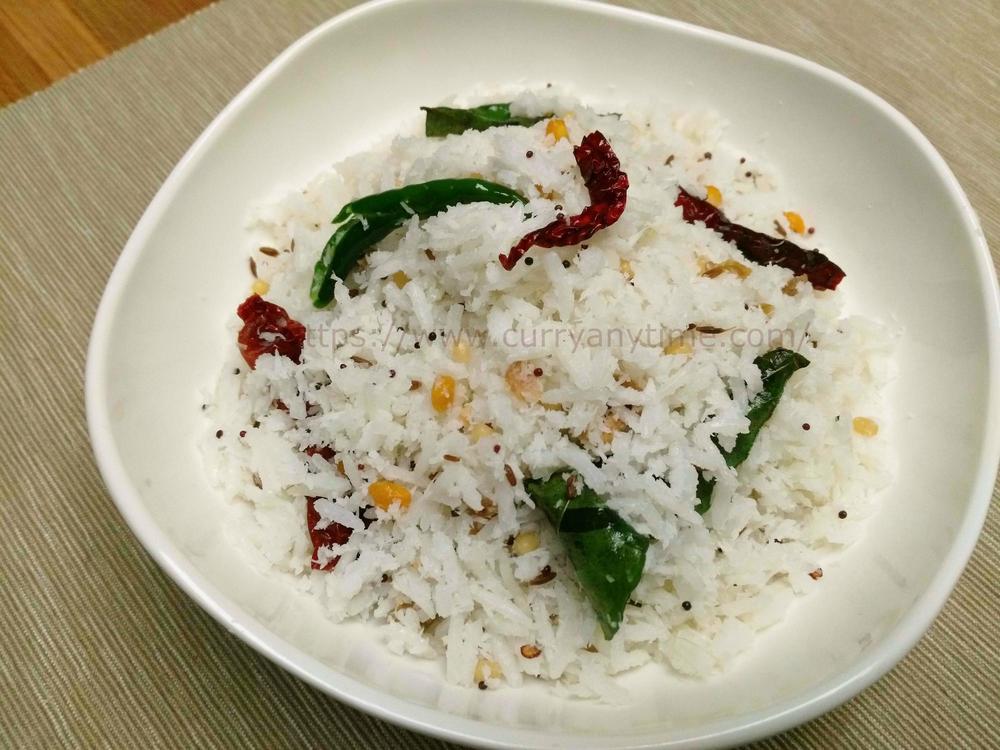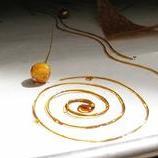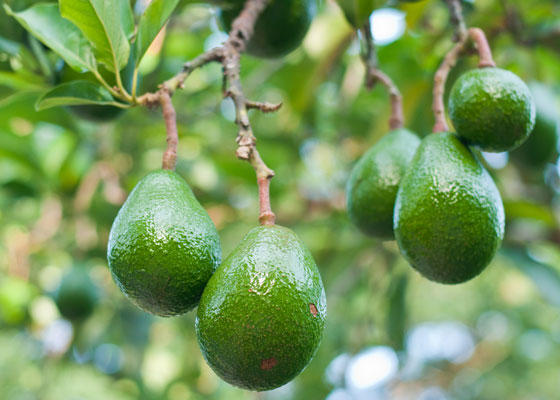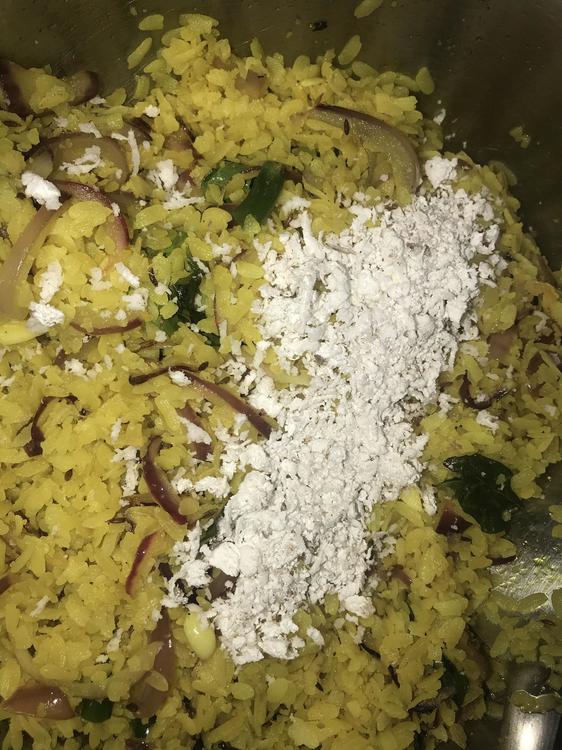Search the Community
Showing results for tags 'Vegetarian'.
-
This stuff has popped up on my radar recently, and I don't see any discussion on it here. IT seems that chickpea canning liquid plus a good beating turns into a air filled protein matrix that does the job of egg white meringue in a lot of applications. https://www.youtube.com/watch?v=kExpx2BzIOQ Anybody here done anything cool with it?
-
Hello friends and welcome back to a time-honored tradition--the popular eG Cook-Off Series. We're in the heat of summer right now and our gardens are literally blooming with all manner of peak of the season ripe fruits and succulent vegetables. And there's no better time of year to honor a vegetable that is often maligned as not being as colorful or trendy as the chi-chi breakfast radish or the multi-hued rainbow chard. In addition to not always being recognized for it's looks, every August and September it becomes the butt of jokes at State Fair competitions across the country. If you can get past the embarassment of seeing the poor devils dressed up and carved into silly, cartoon-like farm figures or pumped-up with organic steroids, you'll find a delicious, low-calorie vegetable packed with potassium and vitamin A. Yes friends, your dreams have come true for today we kick-off eG Cook-Off #62, "Summer Squash." (Click here http://forums.egulle...cook-off-index/ for the complete eG Cook-Off Index). According to the University of Illinois Extension Office, summer squash, (also known in some circles as Italian marrow), are tender, warm-season vegetables that can be grown anytime during the warm, frost-free season. Summer squash differs from fall and winter squash, (like pumpkins, acorn and butternut squash), because it is harvested before the outer rind hardens. Some of the most popular summer squash are the Green and Yellow Zucchini, Scallop, Patty Pan, Globe, Butter Blossom and Yellow Crookneck. My personal favorite summer squash is the versatile zucchini. Slow-cooked with sliced onion and ham hock, zucchini is perfectly comfortable nestled on a plate next to juicy, fried pork chops and creamy macaroni and cheese. But the chi-chi haute crowd isn't forgotten when it comes to zucchini, or, as the sniffy French call it, the "courgette." Tiny, spring courgette blossoms stuffed with herbs and ricotta cheese then dipped in tempura batter and gently fried are a delicacy found on Michelin-Star menus across the globe. Won't you please join me in crafting some delicious masterpieces that showcase the culinary possibilities of delicious summer squash.
-
While not a new cookbook by any means, I haven't really had time to dig into this one until now. We've previously discussed the recipes in Jerusalem: A Cookbook, but not much has been said about Plenty. So, here goes... Chickpea saute with Greek yogurt (p. 211) This was a great way to kick off my time with this book. The flavors were outstanding, particularly the use of the caraway seeds and lemon juice. I used freshly-cooked Rancho Gordo chickpeas, which of course helps! The recipe was not totally trivial, but considering the flavors developed, if you don't count the time to cook the chickpeas it came together very quickly. I highly recommend this dish.
-
I am going to be welcoming a group of Orthodox Jews to my lodge in New Zealand for Christmas and Boxing Day. They are kosher, but are willing to eat fish. What kind of starter do you think we can serve them that will be festive and yet not a violation of their religious observance?
-
I've just finished reading an interesting article about a startup, Impossible Foods, which is working on a plant-based burger that will be indistinguishable from beef to the casual diner (you'll find it here: https://psmag.com/the-biography-of-a-plant-based-burger-31acbecb0dcc#.nfqtah12r). For a while now I've been following the efforts of other researchers to create lab-grown meats (aka "beef in a bottle") from various sources. I've informally polled most of my omnivorous acquaintances about this, and the consensus seems to be that as long as it's 1) a good substitute, 2) price-competitive, and 3) comparable in nutrition, they'd probably give it a try (I live in a frugal part of the world, and price would play a large role here). I'm curious to have the same kind of feedback from any vegetarians and vegans who participate here on the boards. Would you eat a meat substitute that was produced in the laboratory, all things being equal? Would it matter to you that it be all plant-based, or would you be willing to entertain the notion of a "genuine" artificial meat that was created without animals?
-
Courgette cutlets I found the recipe for courgette cutlets at www.gotujzcukiereczkiem.pl. It appealed to me at once for three reasons. Firstly, the courgette is my favourite vegetable. Secondly, cutlets, pancakes and crumpets are my children's favourites dishes. Thirdly, this dish is fast, simple and is always a success. You must not use FB while frying, because it may end with you ordering pizza for dinner The cutlets are mild and their flavour is spiced up with feta cheese. You can complement them with your favourite herbs. In my kitchen there is always basil, dill, peppermint, rosemary and thyme. This time I chose dill (in accordance with the recipe) and thyme. Ingredients: 400g of courgette 1 egg 150g of feta cheese 110g of breadcrumbs (+ 4 tablespoons for the batter) 2 tablespoons of minced dill 1 tablespoon of thyme salt and pepper Wash the courgette and grate it. Add salt and leave it in a bowl for 15 minutes. Drain it then mix in the egg, feta cheese, breadcrumbs and herbs. Spice it up with salt and pepper. Make small cutlets with the mixture and fry in oil. Serve with natural yoghurt.
-
I am a Baker and Cake Decorator in India. India has a huge Vegetarian Population that does not even eat eggs/gelatin. So I am constantly looking at finding vegetarian options. Issue at Hand: Regular Butter Cream - American Butter Cream ( Icing Sugar 10X + Butter + Milk/Lemon Juice / Cream) is an option ..and a lot of decorators use this as it sets hard, and they also add shortening into it ..and I am like , Nope I can't eat that , much less serve it. Its too Sweet /Gritty and Crusts and just tasteless. It has also made sure that people in my country to completely throw out any butter cream cake . You say Butter Cream and they say - too Sweet/gritty. I have been successful in the last two years to break that impression by making European Meringue based butter cream - I love Swiss Meringue Butter Cream . It is smooth, just sweet enough , takes colour well, pipes well , and is mostly temperature stable. But I can't serve it to people who don't eat eggs. I have so far been making a substitute - Ermine/Rue/Cooked Butter Cream - a Flour + Milk+ Sugar custard (AKA Pastry Cream minus the eggs) and whipping butter into it. It tastes good - people like it ..nut its a misery to work with - will not hold shape , will not colour well , and most of all weeps and weeps some more when we chill the cakes. So I am looking for suggestions on finding a starch that will not weep when frozen in a custard? And my second approach is to move to Aqua Faba to build the meringue and make SMBC. The starch custard option is easy and economical and does not leave me with mountains of Chickpeas . would love to hear thoughts . Thanks
- 4 replies
-
- Vegetarian
- Dessert
-
(and 1 more)
Tagged with:
-
Creamy soup with broad beans During my last visit to the fruit and vegetable market I bought so many broad beans that I didn't want to risk cooking everything at once. I prepared a rich, creamy soup with them. The green soup, served with a bit of thick yoghurt and nigella, was very tasty. Ingredients (for 5 people): 1 kg of broad beans half an onion 1 clove of garlic 1 tablespoon of butter 4 sprigs of thyme 1 tablespoon of caraway seeds vegetable stock 5 teaspoons of thick natural yoghurt 2 teaspoons of nigella 2 tablespoons of sunflowers seeds salt and pepper Cook the broad beans in salty water with the caraway seeds, drain and peel them. Try not to eat everything. Chop the onion and garlic and fry them in butter. Put the peeled broad beans, onion, garlic and sprigs of thyme into a saucepan. Pour in the vegetable stock to cover the vegetables and boil for 10 minutes. Take out the thyme and blend the soup to make a smooth cream. Add vegetable stock until you have the right consistence. Roast the sunflower seeds in a dry pan. Serve the soup with thick natural yoghurt, nigella and sunflower seeds. Enjoy your meal!
-
A few years ago I cooked beetroot dauphine to go with roast beef for Crhistmas. From memory it worked well. I basically replaced potato plus roasted beetroot and extra flour in a standard potato recipe (I can't remember the proportions). I am guessing that goats cheese might work well in place of diced bacon. Can anyone recommend a tried and tested recipe?
-
Our Thanksgiving dinner has just enlarged to 7 people, one of whom is vegetarian (no meat, no fish). In addition to the turkey gravy, I'd like to make some gravy that everyone can put on mashed potatoes. The kicker is that the vegetarian does not eat mushrooms, and most of the vegetarian gravy recipes I've found seem to rely on mushrooms. Where do I go from here? Do you have a mushroom-free vegetarian gravy recipe that you like? Is my best bet maybe going to start with caramelized onions and red wine? Thanks!
-
Hi everyone, Been a while since i've posted much here, but I am again faced with an issue that's plagued me for a while and I'm hoping to get some ideas from you... I like making vegetarian dumplings (the asian potsticker/gyoza type) and can never get the fillings to play nice - they're usually too wet and don't hold together very well, making the construction process frustrating, and the eating process less satisfying than the meat counterpart, in my opinion. There's a certain toothsome-ness that I'd like to be able to achieve, but without the meat that usually brings it. I've improved my process by sweating down vegetables to remove some of the moisture, limiting the liquid seasonings and sometimes used a little cornflour to thicken, but it's still not quite where I'd like it. The fillings vary but often incorporate mushroom or tofu, carrot, cabbage, spring onion etc. I'm wondering if perhaps there's a hydrocolloid/magical modernist powder that might be of assistance... i had some vegetarian dim sum recently that really had that firmish, slightly gelatinous texture. See here for the picture (the two on the LHS), you can probably imagine the feel from that. If something like agar would work, I imagine it could be mixed into a tofu-centric filling that would bind everything a bit more. Any ideas? Even just general technique/tips would be welcome (i.e is there anything similar to the breadcrumbs or flour we put in other things to bind and thicken that would do the job without muting flavours)? Thanks, Stu
-
Vietnamese Pickled Eggplant These use tiny white eggplants that are nearly impossible to get here. I tried to grow them without success (this time). I did not have these so used unripe cherry tomatoes. Ingredients 2 lb eggplant (tiny white SE Asian types) or green cherry tomatoes. 1/4 cup salt 1 TBL galangal root 1 TBL ginger root 12 green chilies - thai peppers or serranos 6 cloves garlic 1/2 cup onion finely chopped 2 cup Granulated sugar 2 cup water 1/4 cup fish sauce 1. Rinse off eggplant and pierce with a knife - or cut in half if larger than 3/4 inch in diameter. 2. Put eggplant into jar and add salt - and water to top of jar. Cover with plastic lid and cover loosely. Let ferment for 7 days. 3. Take out eggplant and drain. Rinse with water. Put into jars again. 4. Chop ginger, galangal, chiles, onion, and garlic. 5. Boil water and sugar, add spices and onion, and heat for 5 minutes. Add fish sauce. 6. Pour over eggplants making sure the spices and onion get all around (might have to take out some eggplant and return). 7. Cover with plastic lid, and refrigerate. 8. Ready in several days. Will last a very long time in the refrigerator. Notes: Good alongside other SE Asian dishes, or even alone with rice. The green tomatoes are not the same texture as the eggplants, but are quite good. The eggplants are very crispy.
-
- 1
-

-
- Vegetarian
- Condiments
-
(and 1 more)
Tagged with:
-
Basically, this is a hybrid of the two traditional types of pickles. To my surprise, after a great deal of research, it’s new as far as I can tell. In any event, I came up with it independently. Here’s the story. Several years ago, when developing my recipe for kimchi, I read a lot about natural fermentation. From which I learned the object is to produce lactic acid with the ubiquitous bacterium lactobaccillus plantarum. Meanwhile, I had long ago decided I prefer naturally fermented pickles (e.g., Bubbies) to those cured with vinegar (e.g., Clausen’s). What would happen, I wondered, if I prepared traditionally vinegar-cured pickles with lactic acid directly? At the time, though, I couldn’t find a source. Later, when looking for ingredients for Modernist Cuisine at Home, I happened upon Modernist Pantry and noticed they have the elusive lactic acid in powder form. After numerous trials, I worked out a recipe. It marries the convenience and flexibility of quick curing with the less obtrusive flavor profile of lactic acid. The result isn’t as complex as a natural ferment, but it’s a heck of a lot easier, more reliable and more versatile. The method works with pretty much anything that anyone pickles with vinegar, including cucumbers, beets, mushrooms, turnips, cauliflower, onions, asparagus, green beans, eggs, apples, etc. For convenience and ease of refrigerator storage, I built my recipe around 1 litre canning jars. (Quarts also can be used, of course.) How much main ingredient will fit depends on how closely it packs after prepping, but 1‑1/2 lb is typical. If appropriate, blanch or otherwise cook so as to be tender but not soft. If appropriate, cut into bite-size pieces. For the brine, combine 2 c water, 2 tbsp kosher salt (18 g) and 2 tsp lactic acid powder (6 g). For sweet pickles, e.g., Bread & Butter, I reduce the salt to 2 tsp and increase the lactic acid to 1 tbsp. Notably, according to my electronic pH meter, the 2 tsp lactic acid brine has a starting pH of about 3.2; once it equilibrates with the main ingredient, the pH rises to about 3.8; the recommended level is 4.0 (or less), which is well below the 4.6 needed to inhibit botulism. Flavorings may be added as desired, including garlic, dill, chile, spices, herbs and/or sugar. As with the main ingredient, the flavor profile of just about any vinegar-cured pickle can be adapted for the lactic acid brine. A few practical points. I like to sequester the flavorings in a bouquet garni bag. It’s not necessary, but makes for cleaner pickles. Also, I find infusing the brine works better than cold packing. Bring to a boil, add bag with flavorings and let cool covered. Put bag in bottom of the jar, add main ingredient and pour brine over. Most main ingredients float, so I insert a pickling spacer to submerge them. My favorite spacer is an inverted lid for a stainless steel dredge shaker, available from restaurant supply stores and online (e.g., here and here), as it happens to be exactly the right diameter (70 mm) to fit inside a wide mouth canning jar. An inverted plastic storage cap for regular size jars also works, though it’s a bit too wide (not easy to get in and out of the jar), solid rather than perforated (no brine above the top layer), and, well, plastic. Finally, curing takes at least a few days, but a week works better. Like most quick-cured pickles, texture and flavor generally suffer if held more than a month. Anyhoo, having learned a great deal from the forum, I thought I’d drop this in as my little contribution.
- 2 replies
-
- 4
-

-
- Condiments
- Modernist
-
(and 1 more)
Tagged with:
-
Vital wheat gluten: why use the adjective 'vital'?
falco posted a topic in Food Traditions & Culture
I am trying to perfect a homade/DIY veggie burger recipe. I am trying to understand when, where and how (& the history of) the adjective "vital" came to be so routinely appended to wheat gluten as in "vital wheat gluten" or even less edifying as merely "vital gluten". I understand that one can make one's own wheat gluten by repeatedly rinsing whole wheat flour until all that remains is the protein wheat gluten ("seitan"/'wheat meat'). And by grinding that up one gets wheat gluten 'flour' (aka 'vital wheat gluten) But why use the adjective 'vital'. Apparently 'vital' is not necessarily capitalized & is not a proprietary term. So why is it used but seldom (never, in my experience) explained? I find it a very curious & puzzling situation indeed. Thank you. -
Does anyone have a recipe for Fake Bacon please? I have been vegetarian now for about 3 months. So far it is going very well and I am looking to widen my range of recipes without meat. I am not sure that going down the path of making imitation meets is the best approach but I do enjoy vegetarian soy based sausages and mince (ground beef) - So perhaps an imitation bacon will be good too. If you have any favourite recipes for fake bacon that you wish to share, that would be appreciated. Regards
-
Two of my family members are pescetarian, one of whom is my picky daughter who only likes a few types of fish cooked in very specific ways so to all intents and purposes is mostly vegetarian. Many Chinese soup recipes involve meat or fish, or at least meat broth, so I'd love to find a few more recipes that would suit my whole family (I also don't eat much pork as it doesn't always agree with me, and a lot of soups involve pork so this is also for my benefit!). Vegetarian would be best, or pescetarian soups that are not obviously seafood based (I could get away with sneaking a small amount of dried shrimp in, for instance, but not much more than that!). Any kind of soup will do, although I'd particularly like some simple recipes that could be served alongside a multi-dish meal. But I'm always interested in new recipes so any good soup recipes would be welcome! Any suggestions?
-
Does anyone know of a source for a vegan confectioner's glaze suitable for sugar/chocolate panning (for sealing the candies from the Evils of the Outside World)? I have a couple of friends who are vegan or vegetarian, and I'd like to avoid being a total jerk if I can help it ("Look at these tasty treats I made THAT YOU CAN'T EAT!! MWAHAHA!!"). I need small quantities, as this is just for occasional home use.
-
This is one of my daughter favorite dishes, being mild and less spicy she loves this rice dish. Its super easy to make and goes well with most Indian curries. Do try this out and I am sure you will be happy with the results. Prep Time : 5 mins Cook Time: 5 mins Serves: 2 Ingredients: 1 cup rice(basmati), cooked 1/2 cup coconut, shredded or grated 1 green chili, slit 1 dried red chili 1 1/2 tablespoon oil/ghee(clarified butter) 1/2 teaspoon mustard seeds 1/2 teaspoon cumin seeds 1/2 tablespoon chana dal(split chickpeas) 1/2 tablespoon urad dal(split black gram) 1 teaspoon ginger, finely chopped A pinch of hing (asafoetida) Few curry leaves Salt to taste Directions 1) Heat oil/ghee(clarified butter) in a pan in medium flame. I used coconut oil here because it tastes best for this dish. 2) Add mustard seeds, cumin seeds, chana dal(split chickpeas), urad dal(split black gram), green chili, dried red chili, ginger and curry leaves. Fry this for 30 seconds in medium flame. The trick is to ensure that these are fried but not burned. 3) Add a pinch of hing(asafoetida) and mix well. 4) Now add the cooked rice and coconut. Stir well for about 15 to 20 seconds and switch off the flame. 5) Finally add salt into this and mix well. You could add peanuts or cashew nuts if you prefer. Goes well with most curries.
-
- 4
-

-
- Indian
- Vegetarian
-
(and 1 more)
Tagged with:
-
A few weeks ago I checked out a copy of Madhur Jaffrey's Vegetarian India from the library, and it is well on its way to earning a permanent place in my collection. I've really enjoyed the recipes I've cooked from it so far, and thought I'd share a few of them here. Of course, if anyone else has cooked anything from the book please share your favorites here, too. To kick things off, something that appears in nearly every meal I've cooked this month... a yogurt dish such as Simple Seasoned Yogurt, South Indian-Style (p. 324)
- 95 replies
-
- 8
-

-
- Vegetarian
- Indian
-
(and 1 more)
Tagged with:
-
Years ago, when I visited Tokyo, I ate in a small but fascinating restaurant called 'It's Vegetable' which is now, unfortunately, closed. The chef was from Taiwan, and he made Buddhist vegetarian and vegan dishes that resembled meat. During my visit, several monks wearing robes stopped in to eat dinner. The dishes were pretty amazing. I understood some of them, like using seitan to mimic chicken in stir fry dishes, others used tofu products like yuba, but, others were complex and obviously difficult. One very notable dish we enjoyed was a large 'fish' fillet designed to serve several people. It had a 'skin' made of carefully layered 'scales' cut from nori and attached to the surface. Inside, the white 'flesh' flaked and tasted much like a mild fish. Anyway, apparently Buddhist fake meat meals are very popular in Taiwan and many places, cheap through to fine dining serve them. Yes, if I worked on it for a while, I could probably refine one or two dishes on my own, but, I am wondering if there's a Modernist Cuisine type cookbook for skillfully making these mock meats from scratch? (I have heard that some items are commercially made and available frozen there, much like soy-based burgers are in the US.) I am willing to try almost any offering, even if it's entirely in Chinese. And, I know how to use remailers to purchase regional items from the various local retailers worldwide who do not ship to the US.
-
Ah, the avocado! For many of us, this humble little fruit inspires only one dish. Yet the avocado has a culinary history that is deeper than we may understand. The avocado (Persea Americana) is a tree thought to have originated in South Central Mexico. It’s a member of the flowering plant family Lauraceae. The fruit of the plant - yes, it's a fruit and not a vegetable - is also called avocado. Avocados grow in tropical and warm climates throughout the world. The season in California typically runs from February through September, but avocados from Mexico are now available year-round. The avocado has a higher fat content than other fruits, and as such serves as an important staple in the diet of consumers who are seeking other sources of protein than meats and fatty foods. Avocado oil has found a new customer base due to its flavor in dressings and sauces and the high smoke point is favorable when sautéing meat and seafood. In recent years, due in part to catchy television commercials and the influence of Pinterest, the avocado has seen a resurgence in popularity with home cooks and professionals. Walk into your local casual spot and the menu will undoubtedly have some derivation of avocado toast, typically topped with bacon. Avocados have found a rightful place back on fine dining menus, but unfortunately all too often over-worked dishes with too many ingredients and garnishes erase the pure taste and silky texture of an avocado. When I think of an avocado it’s the Hass variety. However, a friend who lives in Ft. Lauderdale, Florida, can buy Choquette, Hall and Lulu avocados in the local markets. This link provides good information about the different varieties of avocados, when they’re in season and the differences in taste and texture. https://www.foodrepublic.com/2012/10/18/know-your-avocado-varieties-and-when-theyre-in-season/ I for one must challenge myself to start eating and cooking more avocados. I think my recipe for guacamole served with chicharrones is superb, and the cobb salad with large chunks of ripe avocado is delicious, but as a close friend recently said, “one person’s ‘not especially new’ is another’s “eureka moment.” Well said and as history tells us, we’ll find plenty of eureka moments as we discuss and share our tales and dishes of avocado during eG Cook-Off #81: The Avocado. Fun fact: The name avocado derives from the Nahuatl word “ahuacatl,” which was also slang for “testicle.” See the complete eG Cook-Off Index here https://forums.egullet.org/topic/143994-egullet-recipe-cook-off-index/
- 134 replies
-
- 7
-

-
- Mexican
- Vegetarian
-
(and 1 more)
Tagged with:
-
Breakfast in India vs Breakfast in our homes outside India My breakfasts have varied from the time I started to cook for myself instead of just enjoying my Mother’s cooking. At first they were a mix-match of meal fixings, or just dinner leftovers. Or the good old breakfast cereal and milk. But as the years passed and I was more organized, the meals I enjoyed in my Mother’s home began to swim in my memories. And I began to prepare those for my family. However, I am no amazonian chef, so depending on the hectic nature of the days plans, I switched back and forth from convenience with taste, to elaborate and of course tasty breakfasts. We do have both vegetarian and non vegetarian foods but Indian breakfasts will mostly be vegetarian. So here are some of the things I might make: 1. Poha as in mostly ‘kande pohe’. 2. Cheela/ Pudla 3. Masala toast 4. Indian Omelette 5. Handwo piece 6. Thepla 7. Vaghareli rotli 8. Dhokla chutney 9. Idli sambhar 10. Leftover sabji 11. Muthiya 12. Khakhra 13. Upma 14. Paratha 1. Kande Pohe: The dish derives its name from Maharashtra where the Kande Pohe are celebrated as breakfast. They can of course like any breakfast, be eaten at any time. Pohe/ Poha are steamed rice grains that have been beaten flat and then again redried. So they are like Rice flakes. Except they are hand pounded, so have a knobbly texture. You get several varieties in the market. I prefer the thick white variety. 1 cup dry poha per person 1 medium onion sliced 1/2 jalapeno deseeded 1 sprig curry leaves 2 small garlic cloves 1/4 t cumin seeds 1/2 lemon 1/8 t asafoetida 1/4 t turmeric small handful of cilantro leaves 1T fresh grated coconut 2 T Peanut oil salt to taste sugar to taste In a pan heat some oil and add cumin seeds. When the seeds sputter, add sliced onions and stir. Saute on medium heat till they turn slightly browned here and there. Do not burn the onions. Meanwhile wash the Poha in a colander and drain. Do this two or three times to get rid of any dirt and also to allow them to rehydrate. They do not need soaking. Fluff the poha with a fork. Add salt sugar turmeric asafoetida and chopped cilantro. Mix and set aside. Once the onions are ready add minced garlic and chopped jalapeno along with the curry leaf sprig. Turn the heat to low and add the poha mixture. Stir to coat and to allow the turmeric and asafoetida to cook. The poha will turn mildly yellow and start giving a wonderful fragrance. Turn off the heat. Fluff gently and plate. Garnish with fresh grated coconut and a squeeze of lemon juice. Finger licking good!! Now when I make this next I will post a picture. Update: Ok I felt the urge to have Kande Pohe for tonight’s dinner. So here is a picture. I am certain to enjoy it for breakfast as well. The measurement of 1 cup poha per person is too much for one meal. But carried over to another meal thats super good! I will also have some stir fried bok choy greens made in the same kadhai after the poha was done, and some cooked and sliced beetroot for salad. My family will add some haldiram sev on the poha for extra crunch! And we will all have some chaas to round off this meal. ************* 2. Cheela/ Pudla These are essentially crepes but in the Indian style. 1/2 cup sieved garbanzo bean (Besan) flour. Water to form a thin batter 1T plain yogurt 1/2 t ginger garlic paste 1/4 or less green chili crushed 2 t heated oil * pinch asafoetida pinch turmeric salt to taste chopped cilantro (two sprigs) some ‘masala’ from a readymade pickle Method: mix the ingredients together except oil. Heat oil in a separate pan and add about 1 to 2 t of the hot oil onto the batter. It will sizzle. Use a whisk to stir thoroughly. The batter should be pouring consistency. Let the batter soak for about half an hour if possible. On a hot griddle, pour a ladle full of the batter. Turn the griddle with your wrist to spread the batter around. Cook on moderate to high flame. Flip the crepe when all the sides look like they are ready. You can add a little oil to the sides of the frying pan to make the edges crispy. In my home we usually have a Besan cheela with some yogurt its a quick and filling breakfast. You can have a small salad or fruit with it to make it more complete. Or fill the center of the cheela with some cottage cheese and fold for added creaminess! **************** 3. Masala Toast : 1 slice of bread (your choice) toasted 1/2 small red onion minced 1 medium roma tomato diced (or whatever you have) cilantro (few leaves) 1/8 t cumin (optional) 1/4 t chaat masala ( available in stores) 1 inch cube paneer 1 T peanut oil pinch turmeric (optional) Heat the oil in a pan and saute the onions. Add the tomato and cook down to mush. Crumble the paneer and add the dry spices. Stir for a few seconds to warm the paneer. Add the cilantro and though I have not written it as an ingredient, I like a few drops of lemon juice. Do not overcook paneer. I started this topic because someone asked for Indian recipes on the new forum. I don’t think they have seen any yet. I hope they find this useful. I am enjoying it. ************************** I will add recipes to the list slowly. I have to however add that after a certain ‘age’ I have now resorted to having to make sure I have three things for breakfast besides coffee: a glass of water, a small portion of fruit and a small portion of some protein not necessarily meat. Bhukkhad
- 19 replies
-
- 5
-

-
Thanks to @blue_dolphin, I was forced to buy this cookbook and it was delivered today. No matter how hard I try, I just don't super enjoy cookbooks on my Kindle. Anyway, I'll most likely be alone on this thread due to low okra likability lol, but I'm an only child and I'm used to being alone 😁 First on the list will be the Kimchi Okra from page 100--as suggested by @blue_dolphin. I'll be back on this thread soon
-
We are doing a vegetarian feast for (probably) around 20 people at the end of April and I'm still looking for ideas for the courses. Things should have a "wow" factor as most guests are a bit wary regarding the vegetarian theme. Currently, the following ideas are floating around in my head (without having coalesced into distinct dishes): Pressure-cooked mustard seeds as "caviar" (possibly with sour cream and potato soufflé)Marmite consommé (H.B.)Leek "bone marrow"Vichysoisse (but it may be too cold still for this to be a good choice)Potato goulashMaybe some real (fish-friendly harvested) char caviar as contrast/surprise after the fake oneAs you can see, things it needs some structure and a killer idea (which is currently eluding me). Any suggestions?




